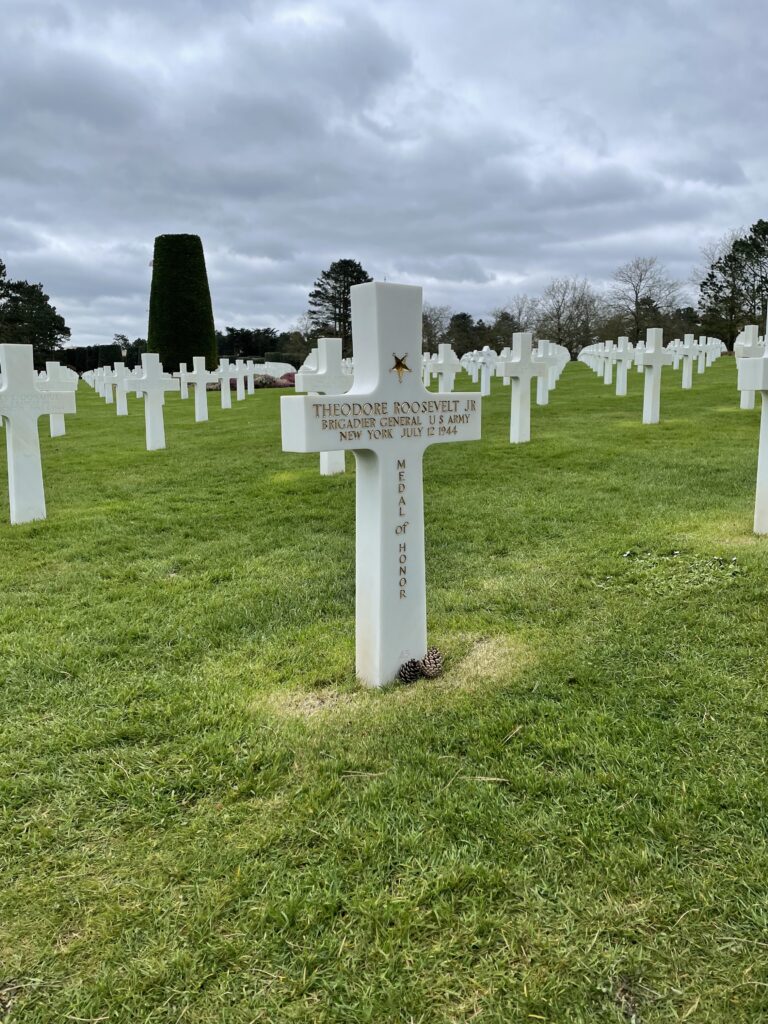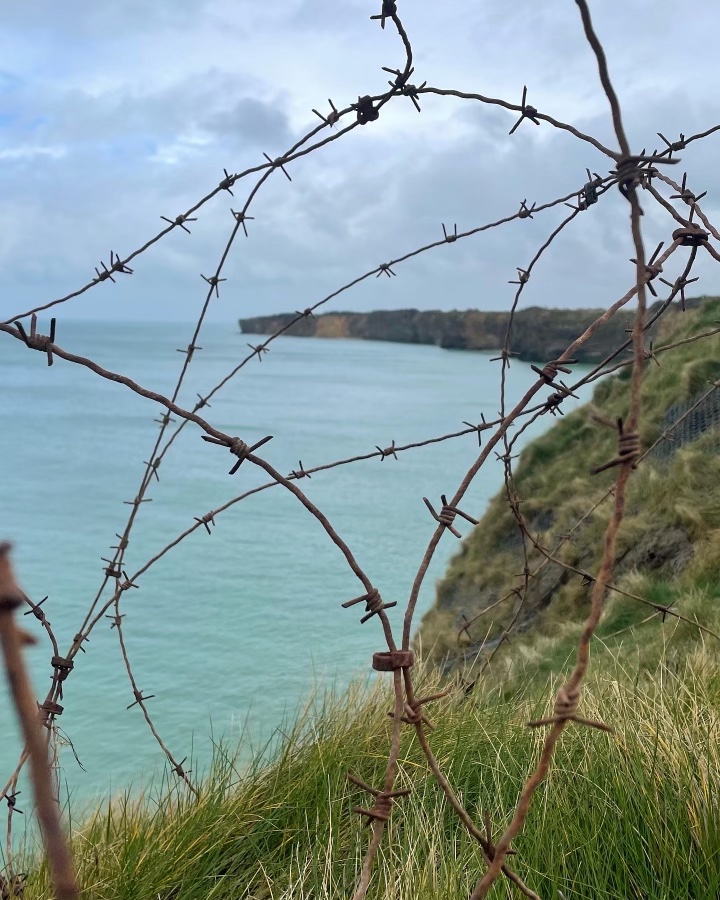I had been to Normandy before. It was 2014 and my dad had traveled to England at the tail end of an internship I had during the spring semester of my junior year of undergrad. Because our plans to visit Normandy together were left up to me — a broke college kid — they were last minute and haphazard to say the least. We traveled by bus, boat (my father gets seasick even looking at water so I owe him for that one), train, and some very kind local’s car at 1 a.m. to even start our journey in Bayeux, France.
Fast forward to 2022 and my journey back to the French coast was seamless thanks to Liberation Route Europe. Despite nearly a decade passing since my first — and dramatically different, i.e. better travel conditions — the emotions Normandy evoked were ever the same.
The graves at the Normandy American Cemetery still faced west towards “home”; the bomb craters that littered the landscape at Pointe du Hoc (although this time roped off) were still mind-boggling; and the beaches of Omaha and Utah were somber as ever.
GET HISTORY’S GREATEST TALES—RIGHT IN YOUR INBOX
Subscribe to our HistoryNet Now! newsletter for the best of the past, delivered every Monday and Thursday.
We all know the sobering statistics. On June 6, 1944, over 160,000 Allied troops were sent to cross the English Channel onto the beaches of Normandy, France. The ensuing operation, dubbed Operation Overlord— launched by General Dwight D. Eisenhower — was the first of many in the fight to liberate Western Europe from Hitler’s grasp. It was the largest amphibious operation in human history.
The operation was successful, but losses heavy. Hitler, believing the attack was a feint, refused to move his troops from northwestern France near the Seine River. This is where he incorrectly believed a larger Allied attack was imminent. As a result, Allied attacks along key supply routes and bridges, superior Allied air power, and German troops having to come from too far afield delayed German reinforcements from reaching the beaches in time, sealed the fate of Nazi Germany.
On the first day, jetlag still slightly plaguing me, I disembarked with my seven other travel companions — half Canadian, half American — onto the crescent-shaped sector of Omaha Beach. I must admit that I felt slight trepidation. Returning to Normandy felt like a pilgrimage, and I felt hesitant doing so surrounded by other members of the press and tour guides from other organizations.
I needn’t have worried, however, as we quickly became “we few, we band of brothers.”
The overcast day seemed fitting as I strolled along the rocky, pebble-strewn beach. The mood somber, although somewhat punctuated by the sound of tourists on electric fat-bikes roving up and down the landscape.
Amid the whirr of those tiny engines, the words of D-Day veteran Gordon Hearne ring in my ear:
Overwhelming death has an eloquence all its own. You walk slowly down a dusty, shell-pocked road, and you are numb. Coherence leaves as you pass by hundreds of bodies still in the attitude of advance … forward … the only way. A spirit more pervading and powerful than the soul within you wilts that soul and lifts it from you, and you are a part of these men, and you know no emotion but humility and have no understanding but the affinity of beings.
From there we traveled via bus to Asnelles, where the 50th British Infantry Division landed, and then on to Ver-sur-Mer — the location of the British Normandy Memorial.
While on that leg of the journey, to quote Stephen Ambrose, “I am always startled to find out how much I don’t know, and delighted at how much I learn.” As our bus navigated the iconically narrow, twisted roads of the French countryside, our guide pointed out that the D-Day planners had forgotten one aspect of the assault plan — whether to drive on the left of the right side of the road if and when the Allies linked up.
As a result, and to avoid injury, Allied leaders hastily ordered that the way of the road changed depending on the sector.
Day two started with me being mostly rested and finally beating back the jetlag. Our superb guides from the Liberation Route Europe are determined that we see and cover all three sectors — American, British, and Canadian — from the battle to liberate France. We bus it to Courseulles-sur-Mer, the Canadian disembarking point on Juno Beach. Soldiers of the Canadian 3rd Infantry Division, in particular the Royal Winnipeg Rifles and the Regina Rifles Regiment, are responsible for seizing the town.
Opened in 2003, the Juno Beach Centre at Courseulles-sur-Mer, seeks to “pay homage to the 45,000 Canadians who lost their lives during the War, of which 5,500 were killed during the Battle of Normandy and 381 on D-Day.”
My 2014 trip with my father was largely American-centric (okay, okay solely) so to see the full scope of the battlefield and how Juno affected my fellow Canadian peers, was humbling indeed.
Inside the museum, the scars of battle were on fully display. A motivational pamphlet reading, cut out to seemingly fit in a Canadian soldier’s pocket, stopped me in my tracks that day. Two bullets were fired through it, making several of the words almost impossible to make out. It read:
SUCCESS
If you think you are beaten,
you are;
If you think you dare not,
you don’t;
If you’d like to win, but think
you can’t,
It’s al— a cinch you won’t.
If you think you’ll lose, you’re lost;
For out in the world we find
Success begins with a fellow’s will,
It’s all in the state of mind.
Life’s b— don’t always go
To the stronger or faster man;
But soon or late the man who wins
Is the one who thinks he can.
It remains unclear whether the man who carried such sentiments lived or died.
From Juno we made our way west, towards the artificial harbor of Arromanches. The port, according to the Liberation Route Europe, is one of two “artificial, pre-fabricated ports in Normandy. These were considered essential for bringing reinforcements and equipment to the Continent.”
Today, the remains of the man-made harbor are still quite visible to the naked eye, bearing a “silent witness to this bold gamble and stunning technical achievement.”
Despite it being past 1 p.m., the day had only really begun, with trips to the Normandy American Cemetery and Memorial, Pointe du Hoc, and the German Military Cemetery at La Cambe still on the horizon.

Continuing our westward journey, we reached the hallowed grounds of the American Cemetery in Colleville-sur-Mer.
Of my scattered notes from the trip, I distinctly put this quote, said in passing by our guide, in bold: “The duty to respect is different than the duty to protect.”
Here, on the bluffs overlooking “Bloody Omaha” and the English Channel, the French and American caretakers do both.
The site, home to 9,388 headstones on over 172.5 acres of land is impeccably maintained by 25 gardeners who work year-round to ensure that this solemn and poignant place remains so.
Moving farther west still, lies Pointe du Hoc — the site of where U.S. Army Rangers under Colonel James Earl Rudder scaled 100-foot cliffs, sometimes with only their bare hands and knives, to seize the German artillery pieces that had their sights aimed on Omaha and Utah.
While the wear and tear of millions of visitors over the years has required the American Battle Monuments Commission to recently section off the bomb-cratered landscape, for me, Pointe du Hoc remains the defining visit during both of my trips to Normandy.
There is no better place to see the scars of the war than here. From the German fortifications that contain steel-reinforced concrete at least six feet thick, the massive bomb craters that litter the landscape, to the shocking views below, Pointe du Hoc should be on any WWII aficionados bucket list.
By the third day we all departed for Belgium to head towards Mons and Bastogne, but that’s another story entirely…
historynet magazines
Our 9 best-selling history titles feature in-depth storytelling and iconic imagery to engage and inform on the people, the wars, and the events that shaped America and the world.






